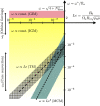Core Eigenmodes and their Impact on the Earth's Rotation
- PMID: 35535257
- PMCID: PMC9050808
- DOI: 10.1007/s10712-021-09668-y
Core Eigenmodes and their Impact on the Earth's Rotation
Abstract
Changes in the Earth's rotation are deeply connected to fluid dynamical processes in the outer core. This connection can be explored by studying the associated Earth eigenmodes with periods ranging from nearly diurnal to multi-decadal. It is essential to understand how the rotational and fluid core eigenmodes mutually interact, as well as their dependence on a host of diverse factors, such as magnetic effects, density stratification, fluid instabilities or turbulence. It is feasible to build detailed models including many of these features, and doing so will in turn allow us to extract more (indirect) information about the Earth's interior. In this article, we present a review of some of the current models, the numerical techniques, their advantages and limitations and the challenges on the road ahead.
Keywords: Core modes; Earth rotation; Rotational modes.
© The Author(s) 2021.
Conflict of interest statement
Conflicts of interestThe authors declare that they have no conflict of interest.
Figures







Similar articles
-
The Viscous and Ohmic Damping of the Earth's Free Core Nutation.J Geophys Res Solid Earth. 2021 Apr;126(4):e2020JB021042. doi: 10.1029/2020JB021042. Epub 2021 Apr 9. J Geophys Res Solid Earth. 2021. PMID: 34221788 Free PMC article.
-
On the genesis of the Earth's magnetism.Rep Prog Phys. 2013 Sep;76(9):096801. doi: 10.1088/0034-4885/76/9/096801. Epub 2013 Sep 4. Rep Prog Phys. 2013. PMID: 24004491 Review.
-
Earth's Variable Rotation.Science. 1991 Aug 9;253(5020):629-37. doi: 10.1126/science.253.5020.629. Science. 1991. PMID: 17772366
-
Recent changes of the Earth's core derived from satellite observations of magnetic and gravity fields.Proc Natl Acad Sci U S A. 2012 Nov 20;109(47):19129-33. doi: 10.1073/pnas.1207346109. Epub 2012 Oct 11. Proc Natl Acad Sci U S A. 2012. PMID: 23064635 Free PMC article.
-
Why is the Earth System Oscillating at a 6-Year Period?Surv Geophys. 2025;46(3):503-528. doi: 10.1007/s10712-024-09874-4. Epub 2025 Feb 10. Surv Geophys. 2025. PMID: 40458537 Free PMC article. Review.
Cited by
-
Inner core static tilt inferred from intradecadal oscillation in the Earth's rotation.Nat Commun. 2023 Dec 8;14(1):8130. doi: 10.1038/s41467-023-43894-9. Nat Commun. 2023. PMID: 38065957 Free PMC article.
References
-
- Acheson DJ, Hide R. Hydromagnetics of rotating fluids. Rep Prog Phys. 1973;36(2):159–221. doi: 10.1088/0034-4885/36/2/002. - DOI
-
- Aldridge K, Lumb L (1987) Inertial waves identified in the earth’s fluid outer core. Nature 325(6103): 421–423
-
- Alfe D, Gillan MJ, Price GD (2003) Thermodynamics from first principles: temperature and composition of the Earth’s core. Mineral Mag 67(1):113–123
-
- Amit H, Olson P. Time-averaged and time-dependent parts of core flow. Phys Earth Planet Int. 2006;155:120–139. doi: 10.1016/j.pepi.2005.10.006. - DOI
-
- Anufriev AP, Jones CA, Soward AM (2005) The Boussinesq and anelastic liquid approximations for convection in the Earth’s core. Phys Earth Planet Int 152(3):163–190
Publication types
LinkOut - more resources
Full Text Sources
